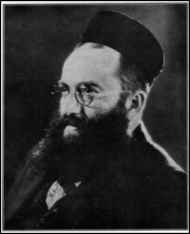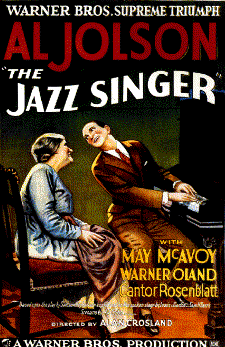Chazzanut Online
- Rosenblatt
Cantor Yossele Rosenblatt,
Some Notes

 Yosef
"Yossele" Rosenblatt (1882-1933) is generally considered to be the
uncrowned king of cantorial music. People often refer to him just as
"Yossele," a Yiddish diminutive of Josef. Yosef
"Yossele" Rosenblatt (1882-1933) is generally considered to be the
uncrowned king of cantorial music. People often refer to him just as
"Yossele," a Yiddish diminutive of Josef.
There is a famous joke about a Cantor who calls himself the Third
Yossele Rosenblatt... When he's asked who the Second Yossele Roseblatt
might be, in great offense he retorts, "There could BE no Second Yossele
Rosenblatt!"
Rosenblatt's greatest hit was his recording of "Shir Hama'alot," Psalm
126, to a tune composed by Minkowsky. This psalm is said on festive
occasions, just before the "Grace after Meals." This cheerful melody
became so popular, that soon it was considered to be the traditional
tune for this psalm. When the State of Israel was looking for a suitable
National Anthem, Rosenblatt's "Shir Hama'alot" was proposed as a serious
candidate.
You can listen to a mp3 of Shir
Hama'alot (2.8M).
Chazzanut Online features the 1928
Recitatives
Book of cantor Rosenblatt and a short
biography.
In his foreword to this book, Rosenblatt wrote about his own recitatives:
"In producing them I was moved by the double impulse of serving the
needs of the Jewish Cantor and of demonstrating to the musical world at
large that genuine Jewish Chazanuth can still satisfy completely even
the refined taste of today. ...I shall feel amply rewarded for my
efforts when I shall see this work widely disseminated."
There is a discography of Chazzan Rosenblatt by Dr. Joseph Greene in a
British magazine called "The Record Collector," Vol. 20, Nos. 6/7 (May,
1972).
According to Henry Sapoznik, the earliest recordings of Rosenblatt were
Mi Shebeirakh and Hasheim Malakh (Pathé, 1905).
Victor Tunkel wrote to me: "I should mention that quite a few things
that he popularised were not written by him. "His" Shir Hama'alot
for example is by Minkowsky. The Chassidic Kaddish is probably by
Jacob Gottlieb, better known as Yankel der Hezeriker. The Retsei
Atiratam is by Machtenberg; and so on."
Cantor Sam Weiss adds: "Rosenblatt also recorded Oshamnu Mikol
Om, a cover of the cantorial hit recorded earlier by the composer,
Cantor David Roitman." This would eventually lead to a court case between Roitman and
Rosenblatt!
Tara published a music book with
songs of Yossele Rosenblatt, compiled and arranged by his son Henry:
"Music of Yossele Rosenblatt."
Rabbi Samuel Rosenblatt published a biography of his father's life.
"Yossele Rosenblatt: the story of his life as told by his son, by Samuel
Rosenblatt. New York, Farrar, Straus and Young, 1954."
There is also some Rosenblatt material in the book "Fifteen Cantorial
Masterpieces," published by Tara.
Cantor Sam Weiss noticed that there is a transcription and recording
of Rosenblatt's V'af Hu Hoyo Miskaven in Tara's book/CD compilation
"Golden Age of Cantors:"
"BTW, this is an excellent resource for good transcriptions
of East-European hazzanut. Some make an attempt at fitting the music to
bar lines, while others provide more accurate transcriptions devoid of
metricality."
David Chevan produced a very
interesting CD called "
Days of Awe : Meditations for Selichot, Rosh Hashanah and Yom
Kippur." It is a collection of instrumental interpretations of
Rosenblatt's compositions for the High Holidays. As such it is one of the
finest "Jewish-Jazz" recordings, and a great Jazz instrumental anyway.
"I came to Rosenblatt years ago when I became interested in Hazzanut,
which is the art of Jewish cantorial singing. Rosenblatt had an incredible
voice and really understood this art form. His krechts, or sobbing sounds,
are profoundly emotional and his phrasing is equally moving. It occurred to
me that I needed to learn more about him, so I began transcribing his
recordings and learning more about the nuances of his singing style,
especially his phrasing," explains bassist Chevan, who teaches at Southern
Connecticut State University.
"The cantorial art of Hazzanut is a highly improvisatory process that
reminds me of jazz improvisation. I hear and have found much more spontaneity
in the singing of cantors than in most Klezmer music (which, incidentally is
often called -- and I believe incorrectly so -- Jewish jazz)," he says,
noting that he chose to transcribe Rosenblatt's renditions of High Holy Day
prayers for several reasons.
"First, because of his incredible sense of melody. These pieces are
infused with wonderful and emotionally powerful melodies. Second, because he
was one of the greatest recorded masters of Hazzanut. His singing and
improvisations are filled with nuances that are rivaled by only a few other
cantors," notes Chevan. "Thirdly, his compositions are compelling. Each of
the pieces I transcribed was like a miniature oratorio. In each of the pieces
there were at least two or more complete music sections that might contain
moments of operatic recitative, snippets of folk melodies, and large sections
of improvised Hazzanut. When I transcribed and then arranged these for my
band to perform the music came alive in fresh new ways that got me excited. I
could hear and feel the spirit of the High Holy Days, the Days of Awe, in a
new and meaningful way."
"As I was transcribing the various pieces I began to find certain places
and patterns in Rosenblatt's choices as to when he would be in tempered
pitch and when he used quarter-tones. I don't even know if he was aware
that he was making quarter-tones as much as creating certain emphases
that were attached as much to the text as anything else. I get the
sense that he was very aware that the "out-of-pitch" notes created a
certain drama that the congregation would have felt as supplication. In
contrast there are sections, especially when he is singing more in the
Yiddish song/freilakh style (strident and martial at times) that he is
right on the money and everything is in more or less tempered pitch.
Listen to his "Al Kheyt" recording and you'll hear what I mean. When we
recorded that piece and several others for my "Days of Awe" album Frank
London brought in a quarter tone trumpet. Listen to Frank play "Hineni"
on the album and you'll get a good understanding of what microtones can
do on a Hazzones recording."
The The National Center
for Jewish Film at Brandeis University has some original Hollywood
material (The Jazz
Singer [1927], The Voice of Israel [1931], Dream of my People
[1933]) as well as some documentary films featuring Rosenblatt
[1882-1933].
Read the story of Rosenblatt's
involvement in The Jazz Singer.


 Last update: 04 January 2006
Last update: 04 January 2006
Url: http://www.chazzanut.com/rosenblatt/rosenblatt-notes.html
Keywords: Yossele Rosenblatt, Yosef Rosenblatt, Cantor, Recitative, mp3.
|